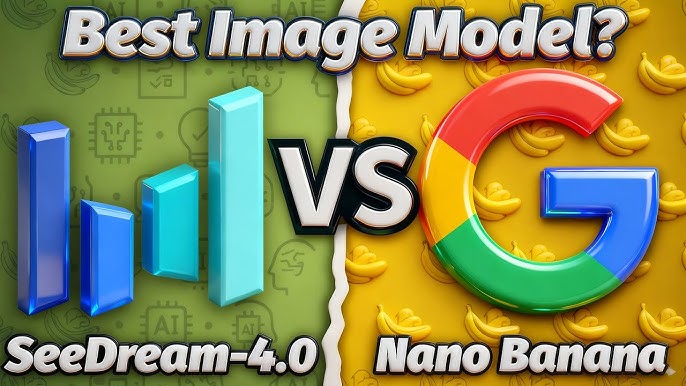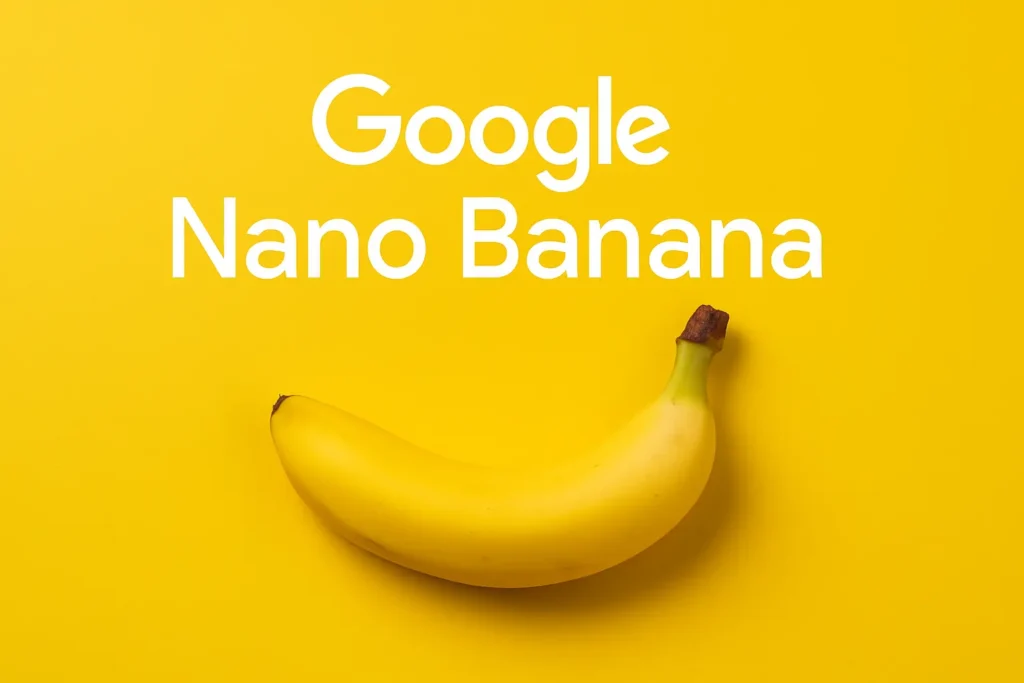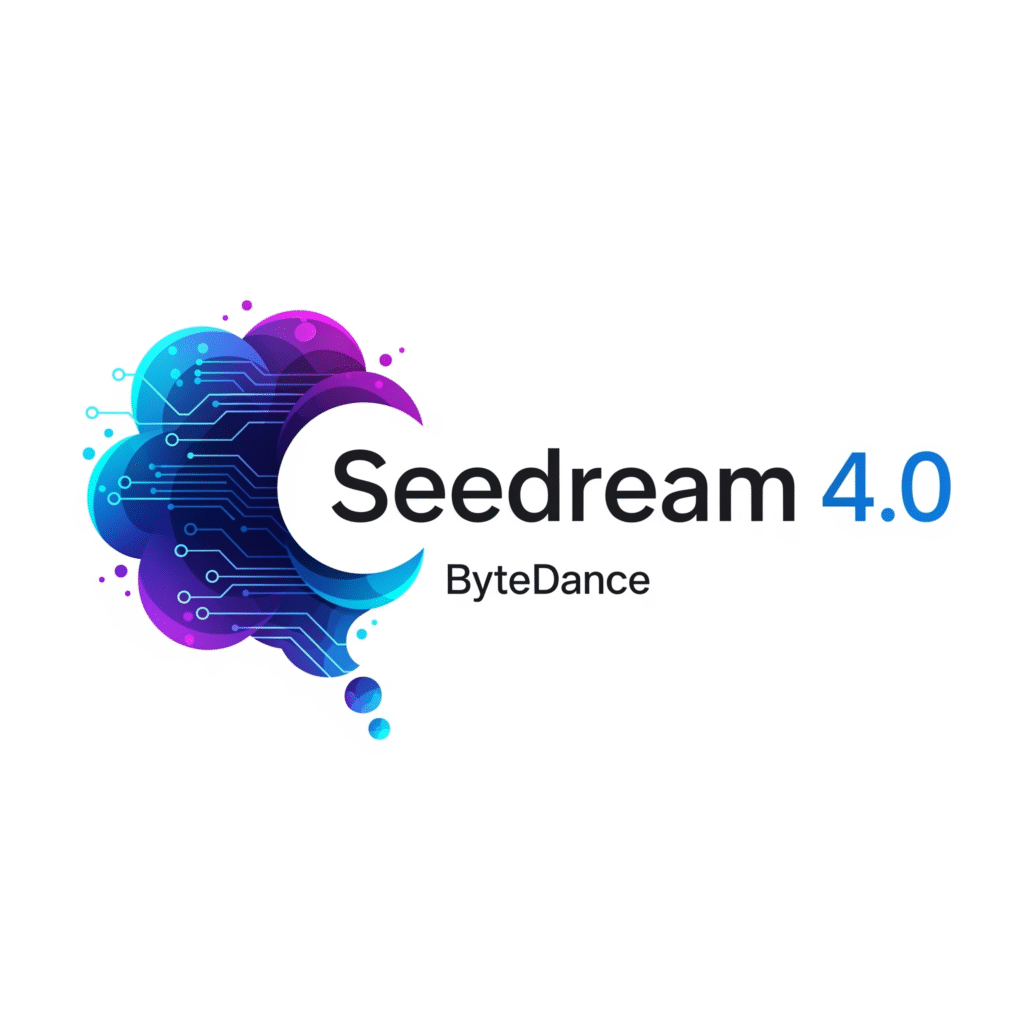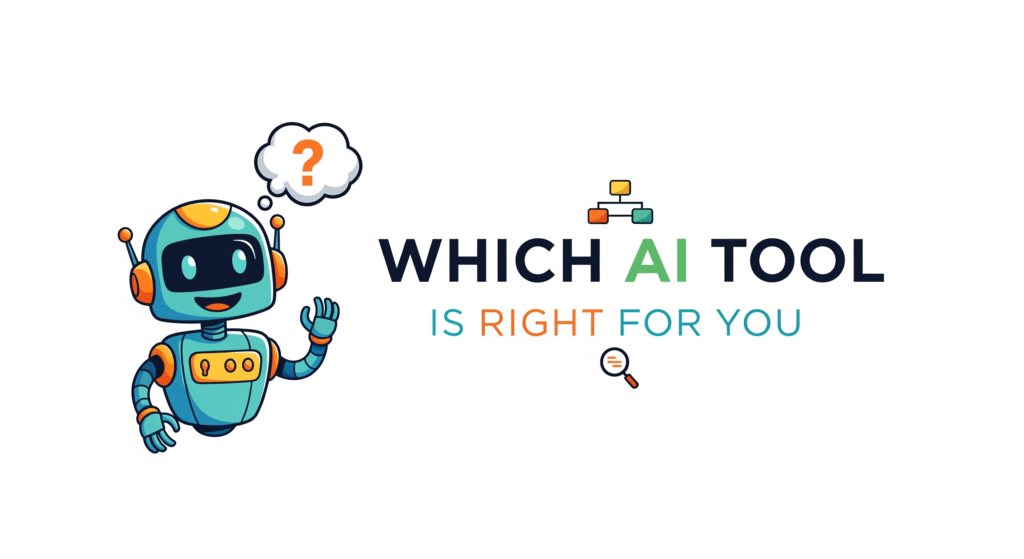While Google’s viral hit captured the internet’s imagination, ByteDance quietly built a professional-grade powerhouse that redefines quality, speed, and creative control. Here’s the definitive analysis of the AI tool that just dethroned a giant.
The Viral Sensation vs. The Silent Giant: Setting the Stage

In the fast-evolving landscape of artificial intelligence, dominance is often perceived through the lens of public visibility. By this measure, Google’s Gemini 2.5 Flash Image, affectionately nicknamed “Nano Banana” by its global user base, was the undisputed champion. It exploded onto social media, fueling a viral trend of creating hyper-realistic 3D figurines that captivated millions. The tool’s integration into the Google Gemini app led to a surge of over 10 million downloads, and users generated more than 200 million images, cementing Nano Banana as a cultural phenomenon and a symbol of Google’s prowess in accessible AI. It was fast, fun, and seemingly unbeatable.
Yet, while Google was winning the popularity contest, a silent giant was preparing its response. ByteDance, the parent company of the viral content machine TikTok, was developing its own contender: Seedream 4.0. Positioned not as a tool for social media fads but as a professional-grade platform, Seedream 4.0 emerged as a direct rival built for a fundamentally different purpose—delivering unparalleled quality, speed, and creative control to a more demanding audience of designers, marketers, and enterprise clients.
The battle for AI supremacy is increasingly fought in the court of public opinion, where viral trends often create a perception of dominance that can obscure deeper, more significant technological shifts happening behind the scenes. Google’s Nano Banana achieved massive mindshare not because it was necessarily the most powerful model, but because it was brilliantly packaged for mass consumption—it was accessible, intuitive, and powered a highly shareable social media trend. This masterfully crafted user experience built a powerful public narrative of Google’s unassailable leadership in image AI. ByteDance, a company that understands virality better than almost any other, made a calculated decision not to compete on the same battlefield. It sidestepped the fleeting world of social media challenges and instead targeted a higher-value, less visible market: the professional sector. The result of this strategic divergence is a fascinating disconnect. While the public continues to associate AI image editing with Nano Banana, industry benchmarks and professional users are now pointing to a new leader. This report will demonstrate that while Nano Banana won the internet’s heart, Seedream 4.0 is decisively winning the performance war. This victory is not merely a product-level upset; it signals a critical maturation of the AI market and represents a significant new front in the escalating technological rivalry between the United States and China.
The Reign of Nano Banana: How Google Captured the World’s Imagination

To understand the magnitude of Seedream 4.0’s achievement, one must first appreciate the phenomenon it displaced. Google’s Nano Banana was not just another AI tool; it represented a paradigm shift in how generative AI was perceived and used by the general public. It was a masterclass in product-market fit, transforming a complex technology into an effortlessly engaging creative experience.
What is “Nano Banana”? The Tech Behind the Trend
The nickname “Nano Banana” was born from the online community, a playful moniker for Google’s officially named Gemini 2.5 Flash Image. The name perfectly captures its design philosophy: a lightweight, nimble, and powerful model engineered for speed and efficiency. Integrated seamlessly into the Google Gemini app, it was designed from the ground up as a mobile-first tool, making advanced AI image generation and editing accessible to anyone with a smartphone.
Its breakout moment came from a single, brilliantly executed use case: the ability to transform ordinary photos into customizable, hyper-realistic 3D figurines with nothing more than a simple text prompt. Users could upload a selfie and, within seconds, see themselves reimagined as a collectible action figure, complete with glossy textures, a transparent acrylic base, and even a mock-up of a toy box featuring original artwork. This combination of personalization and high-quality output proved irresistible, sparking a global trend that saw everyone from celebrities to politicians sharing their “mini-me” creations. The core of its appeal lay in its simplicity, speed, and intuitive interface, which removed the technical barriers that had previously confined generative AI to the realm of hobbyists and experts.
Core Capabilities and Viral Use Cases
Nano Banana’s success was predicated on a revolutionary leap in user experience and contextual consistency, not necessarily raw technical power or aesthetic output. Its core innovation was not just making image editing possible, but making complex edits feel intuitive while rigorously preserving the subject’s identity across transformations. This user-centric achievement set it apart from all predecessors.
Its most celebrated feature was its uncanny ability to retain a person’s likeness. Users consistently reported that through multiple, complex edits, the model kept facial features, expressions, and key details remarkably accurate. This consistency gave rise to the theory among users that Nano Banana operates like a “world model,” possessing a native understanding of real-world physics, how light reflects off different fabrics, and how shadows should fall, allowing it to analyze and manipulate images holistically rather than as a collection of pixels.
This deep understanding enabled another of its key strengths: multi-turn, conversational editing. Users could engage in an iterative dialogue with the AI, making a change and then building upon it with subsequent commands, as the model remembered the context of previous instructions. This fluid workflow made the creative process feel natural and collaborative.
Beyond the figurine trend, this powerful combination of likeness retention and contextual awareness fueled a host of other viral use cases. Users could seamlessly place themselves into different historical decades, complete with period-accurate clothing and hairstyles; insert themselves into the cast of famous TV shows like Seinfeld, sitting on Jerry’s iconic couch; step into classic works of art by Van Gogh or Dalí; or generate photorealistic images of themselves at global landmarks. The model’s creative flexibility was further demonstrated in its ability to expertly blend two disparate photos, perform virtual try-ons for e-commerce, and assist in practical tasks like AI-powered interior design.
The Cracks in the Crown: Limitations and User Criticisms
Despite its immense popularity, Nano Banana was not without its flaws. The very design choices that made it a mass-market success also created limitations that left a significant opening for a professional-grade competitor. To make the tool safe, stable, and accessible for hundreds of millions of global users on the free Gemini app, Google had to make specific engineering and policy compromises.
A common complaint among more discerning users was the model’s relatively low native resolution and a noticeable degradation in image quality, particularly after several rounds of iterative editing. While perfectly adequate for viewing on a smartphone screen, the output often lacked the sharpness and detail required for professional applications. Furthermore, some users and critics noted that its output, while realistic, often had a characteristic “plastic AI sheen,” looking less true to life than images produced by more artistically focused models.
Perhaps the most significant frustration for power users stemmed from Google’s content moderation policies. The model’s heavy-handed “safety” filters, designed to prevent misuse on a massive public platform, were often criticized for being overly restrictive and “nerfing” the tool’s creative potential. This created a ceiling on artistic expression that professionals found limiting.
Finally, Google’s approach to managing server demand introduced a level of unpredictability. The company quietly shifted away from clearly defined daily generation limits (e.g., 100 images for free users) to vague, tier-based descriptions of “basic access” and “highest access”. This change, while logical for managing the immense server load from a huge free user base, meant that non-paying users could face throttling or reduced access during peak times, making it an unreliable tool for those with time-sensitive projects. These compromises—lower resolution, restricted creative freedom, and unpredictable access—are precisely what made Nano Banana unsuitable for the professional market. Google’s strategic decision to conquer the consumer space inherently created a power vacuum in the professional and enterprise segments. ByteDance did not just build a better model; it built a model specifically for the high-value market that Google had chosen to deprioritize.
Enter Seedream 4.0: ByteDance’s Professional-Grade Powerhouse

While Google was basking in the glow of Nano Banana’s viral fame, ByteDance was executing a different strategy. It focused its resources on building a tool that addressed the specific pain points of creative professionals, prioritizing raw power, precision, and aesthetic quality over mass-market accessibility. The result is Seedream 4.0, a model whose technical architecture and feature set are explicitly tailored for commercial and enterprise-level work.
The Technology: A Unified, High-Performance Architecture
Seedream 4.0 represents a “significant evolution” from ByteDance’s previous offerings, marking a leap forward in both capability and design philosophy. Its foundation is a
unified architecture that seamlessly integrates text-to-image generation and sophisticated image editing into a single, cohesive model. This eliminates the need to switch between different tools for creation and refinement, streamlining the professional workflow.
To ensure performance at scale, the model is built on a Mixture-of-Experts (MoE) architecture. This advanced design is analogous to having a team of specialized AIs, where only the most relevant “experts” are activated for any given task. The result is a system that is not only highly efficient but also exceptionally stable and reliable under the heavy, continuous workloads typical of an enterprise environment, such as a marketing agency generating assets for multiple campaigns simultaneously.
This efficiency translates directly into two of Seedream 4.0’s most impressive specifications: speed and resolution. The model can generate complex, 2K-resolution images in under two seconds, a blistering pace that allows for rapid creative prototyping and iteration. Crucially, it supports output resolutions of up to
4K (3840×2160 pixels), a clear and decisive advantage for any commercial project that requires ultra-high detail for print, digital advertising, or professional media.
Further catering to its professional audience, Seedream 4.0 incorporates a powerful multi-reference consistency feature. Users can upload up to six reference images, and the model will intelligently extract and maintain stylistic elements, character designs, or specific brand aesthetics across a batch of newly generated outputs. This is a critical function for maintaining visual identity in large-scale branding campaigns, ensuring continuity in storyboards, or producing variations on a theme for product design.
Where Seedream 4.0 Excels: Aesthetics, Control, and Knowledge

Beyond its impressive technical specifications, Seedream 4.0 distinguishes itself through a set of capabilities that directly address the needs of creative professionals. Its development appears to have been guided by a focus on three key areas: aesthetic output, granular control, and a unique form of “knowledge-driven” generation.
First and foremost, the model is engineered for aesthetic superiority. Unlike the often-functional or playful output of consumer-grade tools, Seedream 4.0’s generations are frequently described as possessing a cinematic quality. The model excels at creating images with sophisticated composition, nuanced lighting, and rich textures, with an overall artistic sensibility that has drawn comparisons to the industry’s aesthetic benchmark, Midjourney. This focus on “AI aesthetics” ensures that the final output is not just a literal interpretation of a prompt, but a visually compelling work in its own right.
This artistic flair is paired with an extraordinary level of prompt-based precision editing. Using simple natural language, users can perform highly specific and complex manipulations. The model can, for instance, change the text on a poster in an image while perfectly preserving the original font, color scheme, and alignment; it can seamlessly remove a person from a crowded photo; or it can take a black-and-white photograph, colorize it, and digitally repair scratches and blemishes, all from a single-sentence command.
Perhaps its most unique and powerful feature is its capacity for knowledge-driven generation. Seedream 4.0 demonstrates a sophisticated ability to reason and draw upon a vast well of embedded knowledge to create accurate, information-rich visuals. It can generate complex educational diagrams, such as a chart illustrating vegetation distribution across different climate zones; it can draw a system of binary linear equations, complete with the steps to solve them, on a virtual blackboard; it can create a detailed historical timeline of Chinese dynasties with appropriate iconography; and it can even produce a professional-grade architectural comparison chart contrasting Gothic and Baroque styles. This capability moves beyond simple image creation into the realm of visual information synthesis, a powerful tool for educators, researchers, and technical illustrators.
The Benchmark Battle: How Seedream “Crushed” the Competition
The claim that Seedream 4.0 “crushed” Nano Banana is not mere hyperbole; it is rooted in objective, third-party data. On the Artificial Analysis leaderboard, a widely respected platform that ranks AI models on quality, speed, and cost, Seedream 4.0 surpassed Google’s model to claim the number one position for both text-to-image generation and image editing. This decisive victory on a neutral, public benchmark sent a clear signal to the industry that a new state-of-the-art model had arrived.
ByteDance has also reported its own internal testing results using a benchmark it calls MagicBench. According to the company, Seedream 4.0 significantly outperformed Nano Banana across core dimensions, including prompt adherence (how well the model follows instructions), alignment (how well edits match the source image), and overall aesthetics. While these results should be viewed with the caveat that they have not yet been published in a formal technical report, they align with the findings from the public leaderboards.
However, the story becomes more complex when moving from quantitative benchmarks to qualitative user experiences. While benchmarks are crucial, they may not fully capture the nuances of creative tasks. This is where a split decision emerges. Many side-by-side comparisons confirm Seedream’s superiority in aesthetic quality and its remarkable ability to adhere to complex, multi-part prompts. Yet, for the specific task of editing a personal photo to create a realistic “mini-me,” many users still find Nano Banana to be superior. Its native understanding of the source image allows it to preserve a person’s likeness with greater fidelity, whereas Seedream, in some tests, has been observed to produce a higher-quality image that bears less resemblance to the original subject. Some users have theorized that this discrepancy arises from different underlying mechanisms: Nano Banana appears to analyze the reference image natively, while Seedream may rely on a text-based description of the image, potentially losing subtle details in translation. Others have suggested that Seedream’s higher benchmark scores could be partly influenced by less restrictive censorship, allowing it to generate a wider range of outputs that users rate more favorably.
This paradox reveals a crucial truth about the current state of AI evaluation. The term “crushed” is accurate within the defined parameters of standardized benchmarks, which heavily reward prompt adherence and visual appeal. However, the real-world user experience shows that the “better” tool is entirely dependent on the user’s specific goal. This highlights a growing challenge for the AI industry: the need to develop more sophisticated evaluation methods that can measure not only technical precision but also the subjective, and often more important, quality of creative and contextual realism. The debate between Seedream 4.0 and Nano Banana serves as a perfect case study for the limitations of relying on numbers alone to declare a winner in a creative arms race.
At-a-Glance Comparison: Seedream 4.0 vs. Nano Banana
To distill the extensive analysis into a clear, actionable summary, the following table provides a head-to-head breakdown of the two models across key features. This format is designed to give users a quick reference for understanding the fundamental differences in their design, performance, and intended applications. For anyone deciding which tool best fits their needs, this comparison offers a direct path to an informed choice.
| Feature | Seedream 4.0 (ByteDance) | Gemini 2.5 “Nano Banana” (Google) |
| Primary Target Audience | Professional Grade (Agencies, Studios, Marketers) | Casual Creators & Social Media Users |
| Maximum Resolution | Up to 4K (3840×2160) | Lower native resolution, optimized for screens |
| Key Strength | Aesthetic Quality, High Detail, Style Versatility | Realism, Likeness Retention, Contextual Logic |
| Generation Speed | < 2 seconds for 2K images | Extremely fast, real-time feel |
| Editing Focus | High-precision, prompt-based control | Playful transformations, multi-turn iteration |
| Core Architecture | Unified Generation & Editing, Mixture-of-Experts (MoE) | Lightweight, mobile-first, native image analysis |
| Multi-Reference Input | Yes, up to 6 reference images for consistency | Excellent consistency from a single reference photo |
| Cost (Approx. per image) | ~$0.03 – $0.039 | ~$0.03 – $0.05 |
| Benchmark Rank (Art. Analysis) | #1 (Text-to-Image & Editing) | #2 |
| Current Availability | Domestic China (Doubao, Jimeng) & Enterprise Cloud | Global via Google Gemini App |
A Practical Guide: Which AI Tool is Right for You?

The competition between Seedream 4.0 and Nano Banana is not a zero-sum game. The “better” tool is the one that aligns with a specific user’s needs, budget, and creative goals. Based on the detailed analysis of their respective strengths and weaknesses, clear recommendations emerge for different user segments.
For Professionals (Marketers, Designers, Brands)
For any user operating in a commercial or professional capacity, Seedream 4.0 is the unequivocal winner. Its feature set is tailor-made for the demands of modern business. The ability to generate assets at up to 4K resolution is non-negotiable for projects destined for high-quality web displays, print advertising, or commercial video. The multi-reference input feature is a game-changer for marketing agencies and in-house brand teams, providing a robust mechanism to ensure absolute brand consistency across large volumes of creative assets, from social media campaigns to product packaging. Furthermore, its blistering generation speed enables the rapid prototyping of concepts, dramatically shortening creative cycles and allowing teams to test ideas more efficiently. Finally, its superior aesthetic control and cinematic output quality allow for the creation of polished, on-brand visuals that can rival or even replace expensive traditional photoshoots, offering a significant return on investment.
For Content Creators & Hobbyists
For the vast majority of casual users, social media enthusiasts, and hobbyists, Nano Banana remains the undisputed champion. Its primary advantage is its seamless integration into the globally accessible and largely free Google Gemini app, making it the most convenient and approachable tool on the market. Its core strength—the unparalleled ability to retain a user’s likeness through fun and playful transformations—is perfectly suited for creating viral memes, custom avatars, and engaging personal photo edits. The intuitive, conversational editing process lowers the barrier to entry, allowing anyone, regardless of technical skill, to produce impressive results in seconds. For content that is destined for social media feeds and personal enjoyment, Nano Banana’s combination of ease of use, speed, and realism is an unbeatable formula.
For AI Artists & Enthusiasts
For the power user, the AI artist, and the technical enthusiast who seeks to push the boundaries of creative generation, the optimal approach is to use both tools in concert. A sophisticated workflow would leverage the unique strengths of each model. An artist could begin with Nano Banana, using its remarkable ability to blend subjects, maintain character consistency, and ground a scene in realistic physics and lighting. Once a solid compositional base is established, that image could then be imported into Seedream 4.0. There, the artist can apply complex stylistic transformations, enhance the aesthetic with cinematic lighting and textures, and ultimately upscale the final piece to a print-ready 4K resolution. This hybrid approach acknowledges that at the highest level of AI art, mastery comes not from loyalty to a single tool, but from strategically combining the best features of the entire ecosystem.
The Bigger Picture: A New Front in the US-China AI War
The emergence of Seedream 4.0 is more than just a product launch; it is a significant event in the broader geopolitical context of the intensifying technological competition between the United States and China. This rivalry is no longer a distant concern for policymakers but is now playing out in the applications and platforms used by millions worldwide. The Seedream-Nano Banana showdown is a proxy battle in a much larger economic and ideological war, where the competition is not just about building the best model, but about which nation’s entire AI ecosystem—encompassing hardware, software, talent, and governance—will set the global standard.
The “AI Sputnik Moment”
For many observers in Washington and Silicon Valley, the recent wave of high-performance AI models from China, including Seedream 4.0 and the highly efficient DeepSeek, represents an “AI Sputnik moment”. This term, evoking the Cold War anxiety that followed the Soviet Union’s surprise satellite launch, reflects a growing concern that the United States’ long-held lead in AI is eroding faster than anticipated. It demonstrates that Chinese firms are not merely catching up; they are now capable of surpassing leading US models in key performance areas.
Crucially, this progress is often achieved with greater capital efficiency and under significant hardware constraints. Chinese tech leaders are flooding the market with a rapid succession of low-cost, high-performance AI services, directly challenging the high-investment, high-cost paradigm of American giants like OpenAI and Google. This is happening despite aggressive US export controls designed to restrict China’s access to the advanced semiconductor chips necessary for training large-scale models. China’s success in this environment suggests a strategic focus on software and architectural innovations, such as the Mixture-of-Experts (MoE) design used in Seedream 4.0, as a way to bypass hardware limitations and achieve state-of-the-art results more efficiently. This ability to innovate around restrictions is a powerful proof-of-concept for China’s strategy of technological self-reliance.
A Tale of Two Strategies: Open vs. Closed, Global vs. Domestic
The competitive dynamic also reveals two divergent strategic philosophies. Google, leveraging its existing global infrastructure, is pushing for mass adoption through its ubiquitous ecosystem, integrating Nano Banana directly into the Gemini app on billions of Android devices. Its path to dominance is through scale and accessibility. ByteDance, in contrast, has initially focused Seedream 4.0 on its massive domestic market and high-value enterprise clients through its Volcano Engine cloud platform. This follows a common pattern for Chinese tech giants: perfecting a product and business model within the protected confines of the domestic market before launching a strategic global rollout.
Adding another layer to this strategic chess match is the aggressive push towards open-source models by Chinese companies like Alibaba and Z.ai. By releasing powerful models to the public, they aim to accelerate innovation, capture the loyalty of the global developer community, and establish their architectures as industry standards. This open-source offensive acts as a form of technological soft power, forcing traditionally more closed US companies like OpenAI to react and release more open models of their own to stay competitive.
The Geopolitical Fault Lines: Data, Censorship, and Trust
Despite its technical superiority, Seedream 4.0 faces significant, non-technical hurdles to potential global adoption. Any technology originating from China is subject to intense scrutiny in the West regarding data privacy, potential government access to user information, and content censorship. Chinese national security laws often require tech companies to comply with state requests for data, a reality that creates deep-seated trust issues for international users and governments.
These concerns are not abstract; they have the potential to create a “digital iron curtain,” a scenario where the world’s technology landscape becomes fragmented into two distinct, often incompatible, spheres of influence—one led by the US and the other by China. In such a world, Western users, corporations, and governments might consciously choose a technically inferior but more trusted US-based model over a superior Chinese alternative due to overriding security and political concerns. This means the competition is not just about technological merit but about fundamentally different models of digital governance. The West champions a model that is nominally open but largely controlled by private corporations, while China advances a state-influenced ecosystem where technology is closely aligned with national strategic goals. The long-term winner of the AI race may not be decided by benchmark scores alone, but by which of these ecosystems proves more resilient, adaptable, and attractive to the global market—particularly in the nations of the Global South, where factors like cost, accessibility, and scalability are paramount.
Conclusion: The Shift from Viral Fun to Professional Power
The meteoric rise of Google’s Nano Banana was a landmark event, a testament to the power of user-centric design in making complex AI technology accessible and delightful to a global audience. Its viral success democratized AI image editing, transforming it from a niche capability into a mainstream cultural touchstone. However, the arrival and subsequent benchmark dominance of ByteDance’s Seedream 4.0 marks a pivotal moment of maturation for the entire generative AI market. The narrative is now shifting from playful novelty to the serious business of professional-grade tools that deliver tangible, commercial value.
Seedream 4.0’s victory on key industry leaderboards is far more than a simple win for ByteDance. It is an unambiguous signal that the era of unchallenged American dominance in frontier AI is over. The landscape is now a fiercely contested, multi-polar world where innovation can emerge from anywhere, often driven by different strategic imperatives and economic models. The competition will no longer be fought on the single axis of raw model performance but on a complex battlefield that includes cost-efficiency, aesthetic sophistication, architectural innovation, and, increasingly, geopolitical influence.
In this intensified race to the top, the ultimate beneficiary is the user. Whether a casual creator delighting in a new social media trend or a global enterprise deploying AI to revolutionize its creative workflows, the accelerating competition between giants like Google and ByteDance will continue to push the boundaries of what is possible, delivering ever more powerful, accessible, and transformative tools into our hands. The king may have been dethroned, but the race for the crown has only just begun.